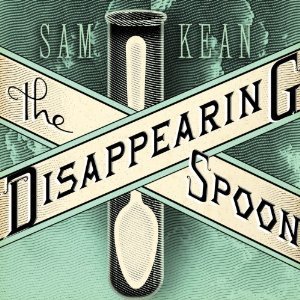- The Good: Intriguing stories about the humans behind the chemical elements
- The Bad: Organizing structure lacks narrative cohesion; overly technical for pop-science
- The Literary: Learning that Mark Twain wrote a story in which Satan is made of the newly discovered radioactive element radium
The periodic table isn’t just a giant chart that hangs in the walls of chemistry classrooms. It’s a grand scientific achievement of discovery and a well honed classification system for the basic building blocks of the universe. What usually isn’t discussed in the classroom are the human stories of how the periodic table came to be, and The Disappearing Spoon aims to teach both in uniformly-sized chapters organized by topics like astronomy, poisons, money, war, and medicine.
There are so many historical, political, financial, and insanely bizarre stories collected in this work that it’s worth the read to find the few that’ll jump out at you. Early in the introduction, you’ll learn that we’ve been able to accurately trace the exact route taken by Lewis and Clark and their company because of mercury-laced pills taken to induce diarrhea and clear the body when ill. And (spoiler-alert!) the title refers to a silly trick in which a spoon is made of gallium instead of aluminum, and since the melting temperature of gallium is low it will melt in your cup of tea. But there is so so much more, and you’re likely to find something of interest somewhere between chemical warfare or art.
I really appreciate that Kean spends some time on the women, minorities, and immigrant scientists that are often glossed over in stories of the humans behind the science. You’ve probably already heard of Marie Curie and Rosalind Franklin, but perhaps not of Lise Meitner, who was the second female to graduate with a doctorate in physics. She discovered nuclear fission with her long-time collaborator Otto Hahn, but she didn’t share in the Nobel Prize because her name was not on the initial publication in Nature in 1939 when, because she was a German Jew, she was living in secret in Sweden.
Although I think this book is written as pop science for the lay-person, it contains too many technical terms and explanations. Don’t get me wrong, I’m all for increasing the general public’s interest and knowledge of science, but in most cases, the paragraphs of orbital descriptions don’t add to the anecdotes, which are really the heart of this collection. It’s almost as if the book can’t decide what it wants to be—an introductory chemistry textbook, history, or pop science. And even at its best, it’s a collection of stories that aren’t tied together in a narrative. There’s no over-arching theme (except the periodic table is cool, but you can’t hang a lasting thesis on that), and you’re presented with so many individual tales that it’s hard to come away remembering more than a handful.
Recommended for anyone interested in the people and history behind the science of the periodic table in need of bite-sized stories that can be consumed slowly.
